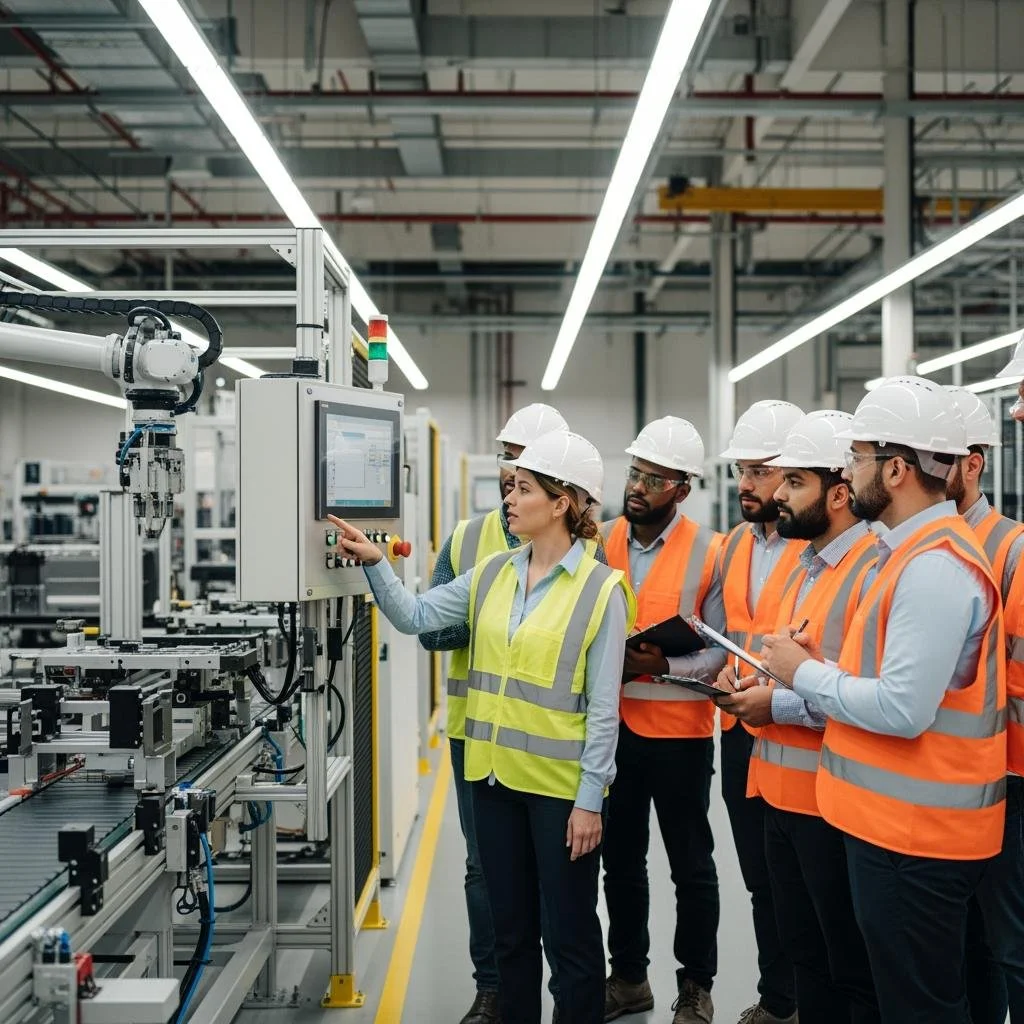Safe Lifting Techniques To Avoid Workplace Injuries
Have you ever lifted something heavy and immediately regretted the way you did it? You're not alone—many workplace injuries result from improper lifting techniques, which not only cause pain and disability but can lead to significant downtime and financial loss for both employees and employers.
Understanding the risks and learning proper lifting techniques are crucial for maintaining a safe work environment. Workplace injuries can have serious consequences for both employees and employers. Not only do they result in pain and suffering for the employees involved, but they can also lead to increased healthcare costs, lost productivity, and damage to a company's reputation.
As an employer, it is your responsibility to take proactive measures to prevent workplace injuries and to create a safe and healthy work environment for your employees. This article provides key strategies to help maintain a safe working environment while employees learn safe lifting techniques to avoid workplace injuries.
Employers: Creating a Safe Workplace Environment
Creating a safe working environment goes beyond individual actions; it requires a systemic approach to workplace safety. Employers must ensure that the work environment is arranged to minimize risks. This includes maintaining clear pathways, properly storing materials, and providing sufficient space for the safe use of tools and equipment.
Ergonomic assessments play a pivotal role in this process. These assessments evaluate how well the work environment fits the needs of its workers, aiming to improve conditions and reduce the likelihood of injuries. Adjustments might include ergonomic chairs, adjustable desks, or rearranged workstations to allow for better posture and less strain during manual handling tasks.
A proactive approach to safety can drastically reduce the incidence of manual handling injuries. By implementing thoughtful design and regular reviews, employers can create a work environment that not only promotes productivity but also guards against the potential for injury that may require a worker comp attorney.
No. 1
Conduct Regular Safety Training
Ensure that all employees receive thorough and up-to-date safety training regularly. This includes training on how to properly use equipment, handle hazardous materials, and follow safety protocols. By providing comprehensive training, you can help employees understand the risks associated with their work and how to mitigate them effectively.
No. 2
Maintain a Clean and Organized Workplace
A cluttered or disorganized workplace can increase the risk of accidents and injuries. Encourage employees to keep their work areas clean and organized, and implement regular cleaning schedules to maintain a safe environment. Additionally, make sure that all equipment is properly maintained and in good working condition to prevent malfunctions that could lead to injuries.
No. 3
Encourage Open Communication
Create a culture of open communication where employees feel comfortable reporting safety concerns and near-miss incidents. Encourage employees to speak up about potential hazards or risks they observe in the workplace so that they can be addressed promptly. By fostering a culture of transparency, you can identify and mitigate safety issues before they escalate into serious injuries.
No. 4
Provide Personal Protective Equipment (PPE)
Equip employees with the necessary personal protective equipment (PPE) to ensure their safety while performing job tasks. Depending on the nature of the work, this may include items such as gloves, helmets, goggles, or ear protection. Make sure that employees are trained on how to use PPE correctly and consistently enforce its usage in the workplace.
No. 5
Implement Safety Policies and Procedures
Develop clear safety policies and procedures that outline expectations for safe work practices. Ensure that these policies are easily accessible to all employees and regularly communicate updates or changes as needed. By establishing clear guidelines, you can promote a culture of safety and accountability within your organization.
No. 6
Manual Handling Training and Assessments
The cornerstone of preventing manual handling injuries is proper training. Employers are responsible for providing manual handling training to ensure that employees understand the risks and know how to manage them. This training typically covers the principles of biomechanics, correct handling techniques, the use of mechanical aids, and the importance of conducting risk assessments.
Regular assessments are also crucial. They help identify potential risk areas in the workplace that might not be immediately obvious. During these assessments, both the tasks and the environment are analyzed to ensure they are as safe as possible. For example, an assessment might reveal that the layout of a workspace forces workers into awkward positions that increase the risk of injury, leading to necessary changes.
The benefits of these training sessions and assessments are clear: they not only minimize the risk of injury but also foster a culture of safety that benefits everyone in the organization. By staying informed and vigilant, employees can actively contribute to their safety and that of their coworkers.
Employees: Understanding Manual Handling
Manual handling refers to any activity requiring an individual to lift, lower, push, pull, carry, or move something by force. It's a routine part of many jobs, from construction sites to office environments. However, it's also a leading cause of injury at work. These injuries can range from mild strains to severe musculoskeletal disorders, affecting not only the back, but also the arms, legs, and neck.
The impact of these injuries extends beyond physical pain. For workers, it means potentially lengthy recovery periods and, in some cases, long-term health issues that could limit future employment opportunities. For businesses, the repercussions include lost productivity, increased insurance costs, and potentially even litigation. That's why understanding manual handling and its risks is not just beneficial—it's essential for a sustainable career and a safe workplace.
No. 1
Basic Principles of Safe Lifting
Proper lifting techniques are not just about using your legs instead of your back. It’s about planning your move before you lift, ensuring your posture is correct, and smoothly executing the lift. First, assess the object. Can you handle it alone? Do you need help or a lifting device? Planning ahead can prevent both immediate injury and long-term wear and tear on your body.
When you're ready to lift, start by standing close to the object with your feet shoulder-width apart. This stance gives you stability. Bend at the knees, not the waist, and tighten your core muscles as you prepare to lift; this supports your spine. Lift slowly and smoothly, keeping the object close to your body to maintain balance and minimize strain. Avoid twisting your back or making sudden movements, as these are common causes of injury.
No. 2
Using Tools and Equipment
Even with the best lifting techniques, some loads are too heavy or awkward for manual handling alone. In these cases, using the right tools and equipment is vital. Items like trolleys, hand trucks, and forklifts can take the strain off human muscles and significantly reduce the risk of injury.
Before using any type of lifting aid, make sure you know how to operate it safely. This might mean undergoing specific training or refresher courses. For instance, using a hand truck requires you to know how to balance the load properly to prevent tipping. Similarly, forklift operators must be trained and certified due to the potential hazards associated with operating such heavy machinery.
In all cases, the proper use of aids not only enhances safety but also improves efficiency in the workplace. Investing in the right tools and training can yield significant returns in terms of productivity and employee health.
No. 3
What to Do If You Are Injured
Despite all precautions, injuries from manual handling can still occur. It’s crucial to know what steps to take if you find yourself injured at work. First, stop what you are doing and report the injury to your supervisor as soon as possible. Early reporting not only helps in receiving prompt medical attention but also assists in the investigation to prevent future incidents.
Seek medical evaluation even if the injury seems minor. Some musculoskeletal injuries may not show immediate severe symptoms but could lead to long-term health issues if not properly addressed. Following medical advice and adhering to prescribed treatment plans is essential for a full recovery.
Furthermore, participate in a post-injury review at your workplace. These reviews can provide critical insights into what went wrong and highlight potential improvements in safety protocols or training programs.
Takeaways
Incorporating safe lifting techniques and proper manual handling practices into your daily work routine is a key factor in maintaining a safe and healthy workplace. Employers and employees must work together to ensure that safety is a top priority, and continuous education on the latest safety standards and techniques is essential.
Remember—taking a few extra moments to assess and prepare for a lift can prevent a lifetime of pain and disability. Committing to a culture of safety that values proactive prevention and cares for the well-being of every team member fosters a conscious workplace environment. Remember, a safe workplace is a productive workplace, and everyone’s health must be a priority.






























